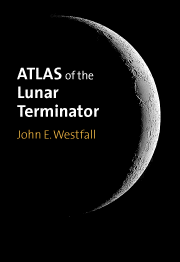Preface and Acknowledgements
Published online by Cambridge University Press: 05 February 2015
Summary
Although there are not a great many atlases of the Moon currently in print, the reader may still wonder why another one has been produced; after all, the Moon hardly changes very rapidly. This atlas differs from others in that it concentrates on the Moon's terminator zone; the area of low solar elevation where the glancing illumination highlights low relief features that are either subdued or invisible under higher lighting. Curiously, it is difficult to find published photographs or other images that show low-lighting areas appropriately exposed. The NASA Lunar Orbiter 4 images that covered almost the entire Moon in 1966-67 showed most areas when the Sun was 16° above their horizon. The Clementine Mission in 1994 obtained many thousand multiband images, but taken at local noontime for each area, so they showed low sun angles only near the Moon's poles! Thus this publication should fill a gap and be of especial use in investigating such lowlying lunar features as ancient basins, ghost craters, domes, and ridges.
Another feature of this atlas is that it shows the earthside face of the Moon at frequent phase intervals, with 47 different illuminations (from about 1.7 days after New Moon to 1.9 days before). Although not perfectly evenly spaced, on the average the views are at intervals of 6°-7° in solar lighting. Thus whenever you observe the Moon, you should be able to find a view in this atlas where the Sun angle differs by no more than a few degrees from what you see in the telescope. This helps in planning observations as well as identifying what one sees in the telescope.
- Type
- Chapter
- Information
- Atlas of the Lunar Terminator , pp. viiPublisher: Cambridge University PressPrint publication year: 2000



